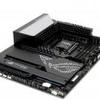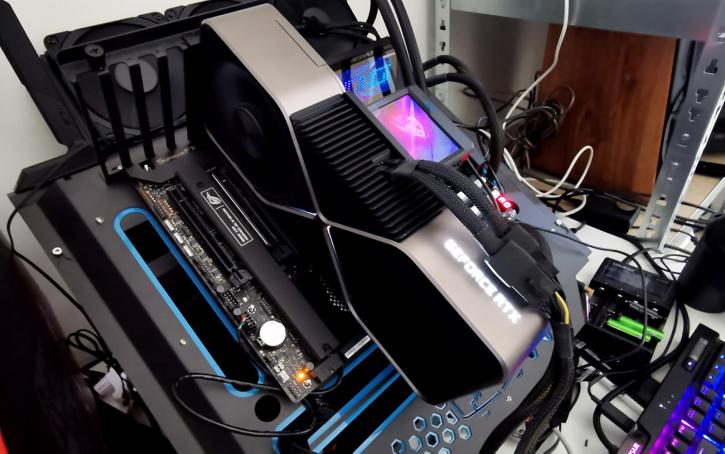Final Words & Conclusion
Final Words
Intel has come a long way, but the new architecture shows very powerful performance cores. ASUS is releasing a total of five motherboards from the same series, including two Maximus Z690 Extreme models. One notable difference is that the Extreme and it's Extreme Glacial water block variant both contain an integrated M.2 slot with a PCIe-5.0 interface, whereas the Z690 does not officially support this. All Maximus Z690 motherboards support only DDR5 memory and have PCIe 5.0 expansion slots. A PCIe 5.0 SSD can only be installed on the other ROG Maximus Z690 boards through the use of an external expansion card (much like our board offers). So yes, I'll probably say this often; a 6 00 EUR/USD motherboard by definition is not faster than a 200 USD one; however it's all about features. What a stunningly beautiful motherboard the HERO is, eh? A sleek, high-end appearance is what you'll gain, and it fits sweetly into this category. It's a beast of a creature, and then some. ASUS employed only high-quality components in this build and continued to add features such as a 2.5 GigE connector and a pretty sweet WIFI6E (AX) network solution. By the way, our AC Wi-Fi test results were good, not perfect, with a throughput of ~600 Mbit/s on a 5GHz single link. It's a v ery decent achievement, though. It is precisely the same with the threefold of M2 slots, which are, by the way, appropriately cooled and then the extra two through the DIMM2 slot, the latter one being PCIe Gen 5.0 compatible you're ready for something swift. We do genuinely cherish this motherboard just for the looks and features.
DDR5 Memory
Memory compatibility should not and likely will not be an issue as long as you stick to QVL supported DIMMs. The sweet spot will be 5200 MHz DDR5 CL40. The more expensive kits will reach CL38. Check out Corsair's, TeamGroup, and G.Skills offering to start with, as they'll have impressive stuff to offer. Nice to see is the new XMP 3.0 profile support. Manufacturers can apply three SPD profiles with more minor changes like latency. Then another two profiles can be stored by the end-user, so you can tweak that memory and keep it directly into the DIMM profiles. Support for this is announced but not yet implemented.
Energy efficiency
With these processors now fabbed at 10nm, you may see some interesting energy efficiency; we expected to drop dead low IDLE energy levels due to the E-cores, but the system comes back at 80 Watts power draw in IDLE, granted our motherboard does have a roughly 5 Watts of RGB going on. Still, even then, it's quite a lot. Under complete stress on the processors, the system came back at roughly 325 Watts and overclocked we reached 450 Watts. Energy efficiency for this motherboard and processors as such are average at best. Keep that in mind with your choice of cooling, as processor wattage used usually is 1:1 in line with cooling performance. We recommend an excellent LCS. Noteworthy is that Intel no longer provides a total design power (TDP), instead referring to a 'processor base power' of 125W and a 'maximum turbo power' that is significantly greater. Intel, at the very least for the overclockable K processors, has ended the confusion that the PL1 and PL2 power constraints produced in previous generations with this announcement. The current norm for these CPUs is that they can boost indefinitely unless the PC maker (or, in the case of self-build, the user) decides otherwise to keep within the limitations of the cooling and power supply systems.
Overclocking
Depending on your objectives, there are numerous approaches to overclock an Intel platform. With the Core i9-12900K, you'll achieve roughly 5.3 GHz across all performance cores. And the proc is going to need something like 1.4 Volts. Most modern motherboards will have an automated setting for that. All eight performance cores were overclocked to 5.3 GHz but at the cost of yet another 125W in energy consumption. We gained 5% extra performance due to this. As such, we feel overclocking is a bit unneeded, perhaps even an illogical thing to do. But you can if you want to, and this platform certainly will assist you greatly with it.
The conclusion
ASUS delivers a compelling infrastructure for Alder Lake with the all new Hero. So who's this motherboard intended for? Well, for those looking for high-end and somewhat extreme features, the HERO series from ASUS is a great choice. Three M.2 slots + two extra on that sweet PCIe Gen 5.0 ready add-in card, overclocking assistance, a more efficient, very luxurious power delivery setup. Then all the USB ports (including Thunderbolt), RGB display, physical buttons for BIOS switching, and a 2.5G LAN connection are all available to you on this motherboard. All things combined make the however a solid foundation for an enthusiast build or a creator PC, depending on your preferences. The answer to the question "should you buy this motherboard?" boils down to how much money you have to spend on it and what requirements you need as this motherboard will be priced at just over 600 EUR/USD. In our belief for lots of people, Alder Lake is what they've been waiting for, a completely new architecture with improved IPC and fabulous overall performance, so lots of people will make the step to upgrade as it also brings PCIe Gen 4.0 and 5.0 as well as DDR5 support and WIFI6E to the table. You'll also receive a sweet audio codec and integrated Wi-Fi 6E technology, as opposed to the others that have been around for a while and so employ last-generation audio and Wi-Fi 6. This board has everything you could ever want in a high-end-class component, thanks to its strong VRMs and cutting-edge features. The BIOS is refined, and overall it'll serve all your needs and then some. If you're looking for an excellent Z690 motherboard and have a budget of roughly $600, the ROG Maximus Z690 HERO is highly recommended albeit pricy.
- Sign up to receive a notification when we publish a new article
- Or go back to Guru3D's front page.



